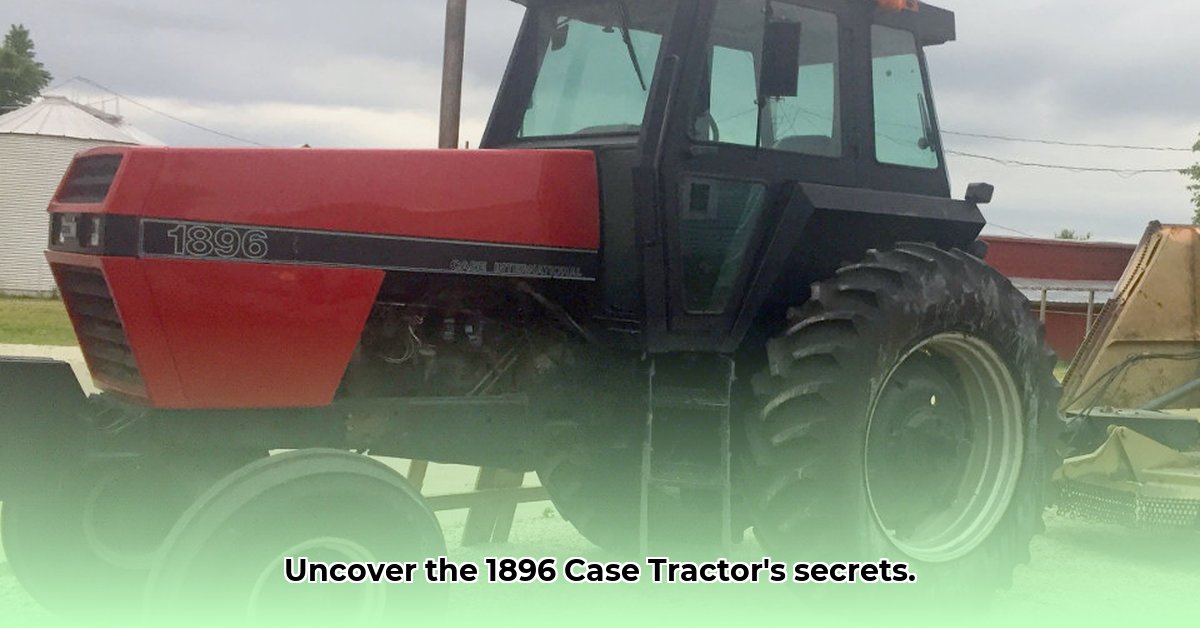
The Case IH 1896 tractor, produced between 1985 and 1989, represents a significant chapter in agricultural machinery history. This article delves into its technical specifications, market performance, and current valuation, highlighting both its strengths and limitations. While comprehensive data remains elusive, we aim to provide a clear picture based on available information. For comparison, you might find information on other tractors like the Ford 5000 here.
Technical Specifications and Design
The Case IH 1896 boasted a robust 5.9-liter, six-cylinder diesel engine, delivering a rated 95 PTO horsepower. Field tests frequently indicated higher real-world horsepower, suggesting a powerful and efficient design. Power was channeled through a sophisticated 12-speed transmission, incorporating a three-speed power shift for smooth transitions between gears – a significant advantage for operators. Hydraulics featured a 25-gallon reservoir and a 2250 psi pressure rating, providing ample power for various implements. Farmers could choose between two-wheel and four-wheel drive configurations, enhancing versatility across diverse field conditions. The tractor weighed approximately 13,495 pounds (6,120 kg).
Did this powerful machine live up to its potential in the marketplace? The answer requires further exploration.
Beyond the Engine: Features and Market Performance
Beyond its raw power, the 1896 offered notable features for its time. The availability of a comfortable cab, including air conditioning, represented a significant improvement in operator comfort. Its compatibility with both Category II and III hitches further enhanced versatility. A subtle detail hinting at a broader historical context is its paint scheme: the tractor transitioned from Case's traditional white to the iconic Case IH red during its production run, reflecting the merger between Case and International Harvester. This change likely impacted marketing and sales, though quantifying this impact requires further research.
Precise sales figures for the 1896 tractor remain elusive, hindering a complete understanding of its market success. While estimates suggest a new price around $35,000 in 1989, more detailed sales data is needed for a comprehensive analysis. Current resale values vary widely depending on condition, hours of use, and included attachments. This variation underscores the lack of readily available historical market data.
Research Gaps and Future Directions
The scarcity of comprehensive data—production numbers, market share, and overall impact on agriculture—represents a critical research gap. Accessing archived Case IH sales records, analyzing contemporary industry publications, and reviewing agricultural economic statistics are vital steps in filling this knowledge gap. This investigation transcends academic interest; collectors and enthusiasts can contribute significantly by creating a comprehensive registry of surviving 1896 Case tractors. This collaborative effort would provide a more detailed account of the tractor's lifespan and market impact. Ongoing research efforts are underway, and our understanding of this machine will likely evolve as more information emerges.
What steps are needed to unlock the full story of the Case IH 1896?
Actionable Research Steps: A Collaborative Approach
Various stakeholders can contribute to a more complete understanding of the 1896 Case tractor. Below we outline potential research goals, categorizing them by time commitment:
Short-Term Goals (0-1 Year):
- Agricultural Historians: Focus on locating and analyzing Case IH production and sales records.
- Collectors & Enthusiasts: Create a detailed registry or database of existing 1896 Case tractors.
- Equipment Appraisers: Refine valuation models for the 1896 based on condition and features.
Long-Term Goals (3-5 Years):
- Agricultural Historians: Develop in-depth case studies examining the 1896's influence on agricultural practices and technology.
- Collectors & Enthusiasts: Conduct thorough assessments of preservation needs for surviving tractors.
- Market Analysts: Develop comprehensive market trend analyses for vintage agricultural equipment, including the 1896.
Valuing a Vintage Case IH 1896 Tractor: A Practical Guide
Determining the value of a used 1896 Case tractor necessitates a careful assessment of its strengths and weaknesses relative to its contemporaries. While it benefits from fuel efficiency due to its smaller Cummins 5.9L engine, it may lack the raw horsepower of models like the 2090 and 2096. However, engine tuning can potentially increase horsepower, though this doesn't address the inherent power limitations. The tractor shares its powershift transmission with the 2094 series, which, while capable, has vulnerabilities related to the printed circuit board (PCB) and potential damage from improper operation.
Critical to valuing the tractor is the availability of replacement parts. Sourcing components, particularly for the drivetrain, can be challenging and expensive, significantly impacting overall value and long-term ownership costs.
Step-by-Step Valuation Process:
- Thorough Inspection: A detailed inspection is crucial to assess the overall condition of the engine, transmission, and other systems. Look for wear, leaks, and any operational issues.
- Operating Hours: Lower operating hours typically indicate higher value.
- Maintenance Records: Detailed maintenance records demonstrate responsible ownership and provide insights into the tractor's history.
- Professional Assessment: A qualified mechanic's inspection is critical for identifying potential hidden problems and providing an accurate assessment of the tractor’s condition and repair needs. This is especially important for assessing the drivetrain’s potential problems.
- Market Research: Research recent sales of comparable 1896 tractors. Online forums and auction data can offer valuable benchmarks, but scarcity of sales transactions requires cautious interpretation.
- Parts Availability: Investigate the availability and cost of replacement parts in your region. Factor these potential repair costs into your valuation.
The value of a vintage 1896 Case tractor is determined by a complex interplay of condition, maintenance history, operating hours, and, critically, the availability and cost of replacement parts. A realistic assessment should account for potential future repair expenses. A well-maintained 1896 can be a valuable acquisition, but due diligence and professional advice are essential.